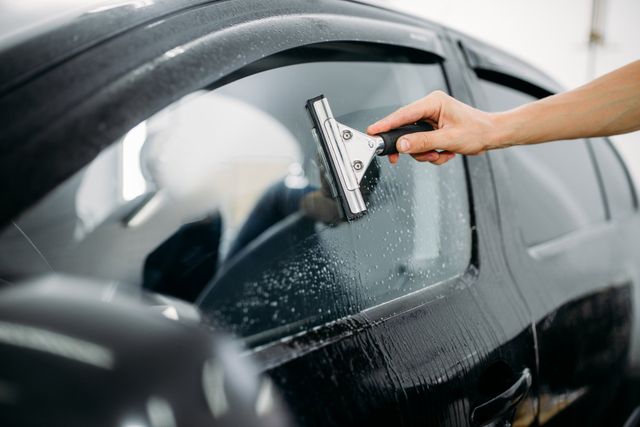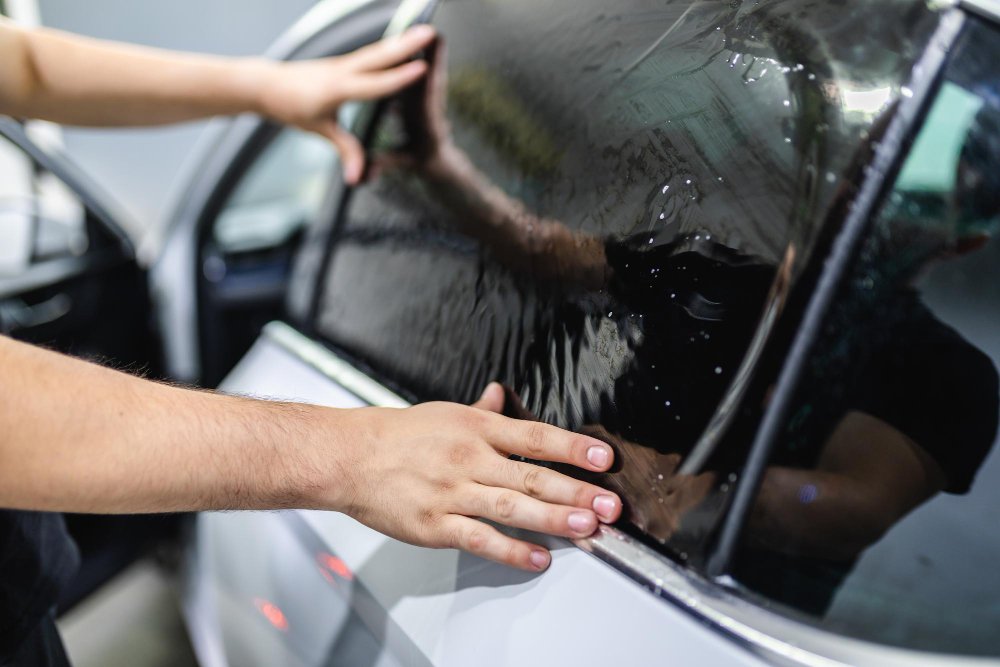A Comprehensive Guide to Comprehending Automobile Window Color and Its Advantages
Auto window tinting serves greater than just an aesthetic objective for lorries. It supplies different types, each with distinctive attributes and benefits. Understanding these options, in addition to lawful policies and upkeep suggestions, is important for any kind of car proprietor. The advantages might substantially improve driving comfort and lorry durability. As one checks out the subtleties of home window tinting, the inquiry occurs: what sort of tint is ideal fit for specific needs?
Recognizing Auto Window Color: What It Is and How It Works
Automobile home window color functions as a safety barrier that improves vehicle appearances while giving functional benefits. This slim movie is related to the interior surface area of auto windows, minimizing glow and blocking damaging ultraviolet (UV) rays from the sunlight. By filtering system sunlight, automobile home window color helps to control the indoor temperature of the automobile, leading to boosted convenience for passengers and minimized dependence on air conditioning.Additionally, it safeguards the vehicle's inside from fading, protecting both upholstery and control panel materials. The tint can also improve personal privacy, making it a lot more hard for outsiders to see inside the car. Particular types of window color can increase security; in the event of a mishap, the film assists hold shattered glass with each other, lowering the threat of injury from flying shards. In general, car home window color offers both sensible and aesthetic objectives, making it a prominent selection among vehicle owners.
Sorts Of Home Window Tint: An Introduction of Options
When considering window tint alternatives, numerous kinds are readily available, each with distinctive characteristics. Colored, metalized, and ceramic window colors use varying levels of heat rejection, UV security, and aesthetic allure. Recognizing these differences can help lorry owners make educated options based on their preferences and demands.
Dyed Window Tint
Colored window color represents a prominent selection among cars and truck owners looking for a reliable and economical means to improve their lorry's aesthetic appeals and privacy. This kind of color is produced by placing a layer of dye between a safety finish and a sticky layer, resulting in a dark appearance that lowers glow and enhances visual convenience. While dyed home window color successfully obstructs damaging UV rays, it may not provide the exact same level of heat rejection as various other color kinds. In addition, its shade can discolor gradually, potentially decreasing its performance. Despite these disadvantages, dyed window tint stays favored for its cost-effectiveness and ability to offer a sleek, fashionable seek to various lorry models.
Metalized Home Window Tint
Metalized window tint provides a balance of style and performance, making it a popular selection amongst cars and truck proprietors. This type of color includes metallic fragments within the movie, enhancing both aesthetic allure and warmth rejection. The reflective quality of metalized tint helps to lower glow and improve privacy, while additionally giving UV protection, which safeguards the vehicle's inside. In addition, metalized window tint can reinforce home window toughness, possibly avoiding shattering throughout mishaps. However, it is vital to keep in mind that the metallic components can disrupt electronic signals, such as GPS and cellular phone function. Generally, metalized home window tint gives a reliable solution for those looking for a mix of durability, look, and sunlight defense for their automobiles.
Ceramic Window Color
Ceramic home window color stands for an innovative option in the spectrum of vehicle home window films, using distinctive benefits over traditional tints. Unlike dyed or metalized movies, ceramic colors use advanced ceramic fragments, which properly reject warm and UV rays without jeopardizing presence. This modern technology ensures that cars stay cooler, decreasing dependence on air conditioning and boosting fuel performance. Furthermore, ceramic window tints are much less likely to conflict with electronic tools, such as GPS or mobile signals, making them a useful choice for modern-day cars. Their sturdiness and scratch resistance add to a longer life-span compared to other kinds of colors. In general, ceramic window color provides remarkable performance, convenience, and protection, making it a preferred choice for critical vehicle owners.
Advantages of Car Home Window Color: Beyond Aesthetics
While several people associate automobile window tint with improved style, its advantages prolong far past simple visual appeals. One considerable benefit is heat decrease; home window color can obstruct approximately 99% of harmful UV rays, keeping the indoor colder and safeguarding upholstery from fading. This not only enhances convenience during hot climate however additionally decreases dependence on a/c, resulting in improved fuel efficiency.In addition, auto home window color provides an included layer of privacy and safety. Colored windows make it difficult for outsiders to see inside the automobile, which can discourage burglary and safeguard belongings. Additionally, numerous colors strengthen the glass, minimizing the probability of ruining in case of an accident, thus improving safety.In addition to these functional advantages, auto home window color can also add to glare reduction, improving visibility for chauffeurs and passengers alike. This complex approach to convenience and safety makes window color a beneficial investment for car owners.
Legal Factors To Consider: Tinting Regulations by State
Prior to dedicating to car window tint, automobile proprietors have to browse a complex landscape of tinting regulations that vary by state. Each state has specific regulations governing the permissible degrees of color darkness and reflectivity for different windows, consisting of windshields, front side home windows, and back windows. These regulations typically include visible light transmission (VLT) portions, which determine just how much light can travel through the tinted glass.Some states permit darker colors on rear home windows while restricting front side and windshield colors for safety and security factors. In addition, particular states may require a certification from the supplier to verify conformity with tinting laws. Breaking these policies can result in penalties, obligatory elimination of the tint, or both. Subsequently, it is essential for car proprietors to research their state's laws extensively to assure legal conformity before setting up window color. This diligence can conserve money and time over time.
Picking the Right Tint: Factors to Think about
When selecting the ideal window color for a car, several important variables enter into play. Tint darkness levels, UV security ratings, and compliance with legal laws are essential considerations to ensure both aesthetics and capability. Assessing these facets will certainly aid people make an informed decision that fulfills their requirements and complies with regional regulations.
Color Darkness Degrees
Choosing the appropriate tint darkness level is crucial for accomplishing the preferred equilibrium between aesthetics and functionality in automobile window tinting. Different states have varying legal laws pertaining to tint darkness, which can influence the option. Normally, colors are gauged in portions, with reduced portions suggesting darker tones. Darker tints use enhanced personal privacy and a smooth appearance yet can reduce exposure, especially at evening. Conversely, lighter tints preserve an even more open feel, making sure sufficient exposure while still giving some heat and glow decrease. When making a choice, individuals ought to consider their driving habits, neighborhood regulations, and individual preferences. Inevitably, the right tint darkness degree improves the automobile's look while making certain safety and security and conformity with lawful criteria.
UV Defense Ranking
Color darkness levels play a substantial role in the general efficiency of vehicle home window tinting, however an additional vital factor to review is the UV protection rating of the selected color. This score indicates the percent of unsafe ultraviolet rays that the tint can obstruct. Top quality colors usually supply 99% or even more UV security, securing passengers and the car's interior from sunlight damage. Davinci of Michigan. Long term exposure to UV rays can bring about skin troubles and fading of upholstery, making a high UV defense rating necessary for wellness and longevity. When picking window color, customers ought to prioritize this score alongside darkness levels to ensure optimum convenience and security while driving. Comprehending these factors aids in making a notified choice when purchasing auto home window tinting
Lawful Regulations Compliance
Recognizing regional lawful laws is vital for any person considering auto home window tinting. Each state or area has specific regulations regulating the allowed levels of color darkness and reflectivity for various home windows. These guidelines typically specify the noticeable light transmission portion, determining just how much light can go through the tinted glass. Non-compliance can cause penalties, obligatory elimination of the color, or problems during automobile examinations. In addition, some locations might have restrictions on making use of particular tinting products, calling for customers to pick items that meet security requirements. It is vital for automobile owners to investigate their neighborhood regulations completely before choosing window color to assure conformity and avoid prospective lawful issues.

Installment Refine: do it yourself vs. Specialist Solutions
How does one determine between a DIY installment and employing professional solutions for auto window tinting? The option commonly depends upon budget, experience, and wanted results. A DIY technique can be economical, permitting individuals to save money on labor expenses. However, it calls for a particular degree of ability and understanding concerning the tinting procedure. Those who are careful and client may locate success with DIY kits readily available in the market.Conversely, specialist services provide proficiency and top notch products, ensuring a flawless surface. Experts commonly assure their work, supplying peace of mind against potential concerns such as peeling or gurgling. Additionally, they are familiar with neighborhood regulations relating to tinting, which can be complicated for the average cars and truck owner.Ultimately, the decision mirrors an equilibrium in between cost, individual ability, and the expected top quality of the tinting job. Each option has its advantages, and the very best option depends on private conditions and choices.
Upkeep Tips: Keeping Your Tint in Leading Problem

Regularly Asked Concerns
How Long Does Window Tint Normally Last on a Vehicle?
Window color typically lasts in between five to 10 years, relying on factors such as top quality, application, and ecological conditions. Regular maintenance and correct care can prolong its life expectancy, ensuring optimal efficiency and appearance over time.
Can Window Tinting Damage My Vehicle's Original Glass?
Window tinting, when applied properly, does not damage an auto's original glass. Inappropriate installation or low-quality products may lead to concerns like bubbling or peeling, potentially impacting the glass's honesty over time.
Is Home Window Tinting Safe for All Types of Cars?
Window tinting is typically safe for most cars, gave the movie abides with local guidelines and is effectively applied. However, some customized lorries might call for specific factors to consider, making it vital to seek advice from specialists before setup.
Will Window Tinting Gap My Car Warranty?
The inquiry of whether home window tinting voids an automobile service warranty usually depends on the manufacturer's policies. Usually, if the color does not damage the automobile, warranties typically stay intact. Nonetheless, speaking with the dealer is suggested.
Can I Remove Home Window Tint Myself if Needed?
Getting rid of window tint oneself is possible, however it calls for cautious interest to prevent damaging the glass. People must make use of suitable devices and methods to guarantee a successful removal without leaving sticky residue or scratches behind. While dyed window tint efficiently blocks dangerous UV rays, it might not use the exact same degree of heat being rejected as other color kinds. Ceramic window color stands for a sophisticated alternative in the range of automobile window movies, offering distinct advantages over conventional tints. Prior to dedicating to automobile home window tint, automobile proprietors need to browse a complex landscape of tinting laws that vary by state. These regulations frequently include visible light transmission (VLT) portions, which determine just how much light can pass with the colored glass.Some states permit darker tints on rear windows while limiting front side and windscreen colors for security factors. Tint darkness degrees play a substantial role in the overall click here performance of car home window tinting, however one more essential factor to examine is the UV protection rating of the chosen tint.